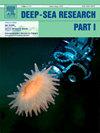Submesoscale ocean dynamic process contributions to diurnal subsurface chlorophyll variation along Lagrangian recirculation inside mesoscale eddies: A case study in the Southern Ocean
Abstract
Studies regarding oceanic mesoscale and submesoscale processes and their impact on chlorophyll are mainly confined to weeks to decadal time scales. Based on biogeochemical-Argo float observations and altimeter data in the Southern Ocean in summer of 2016, we show the day-night chlorophyll difference inside a cyclonic eddy (ΔChlTCE) and an anticyclonic eddy (ΔChlTACE) associated with submesoscale processes. A diurnal cycle of chlorophyll is observed in the upper 50 m, with ΔChlTCE (1.5 mg m−3) as much as ten times that of ΔChlTACE (0.15 mg m−3). However, there are similar ratios of day-night chlorophyll difference to the maximum chlorophyll concentration in a day for the cyclonic and anticyclonic eddies (∼67%). Submesoscale processes present different impacts on the subsurface chlorophyll between the cyclonic and anticyclonic eddies on the diurnal scale. More significant submesoscale processes in the cyclonic eddy dominate the subsurface negative ΔChlTCE. It causes the phytoplankton to penetrate the bottom of the mixed layer and extend ∼50 m below the mixed layer. In contrast, submesoscale processes and their associated with vertical buoyancy flux only generate weak negative subsurface ΔChlTACE. The strong vertical gradient of ΔChlTACE is mainly dominated by the vertical displacement of the deep chlorophyll maximum.

 求助内容:
求助内容: 应助结果提醒方式:
应助结果提醒方式:


